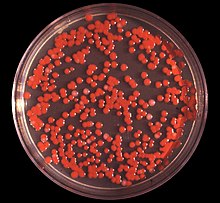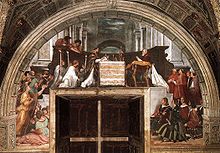Blood miracle
As blood miracle are bleeding similar symptoms in consecrated communion wafers , to images of Jesus Christ , Mary , other saints or their relics as well as re-liquefaction of blood relics. Blood miracles are an expression of Catholic popular piety . If they appear on consecrated hosts, one speaks of host miracles .
overview
The belief in blood miracles was particularly widespread in the 14th and 15th centuries. Places of such blood miracles became the goal of pilgrimages .
Already at the siege of Tire in 332 BC Under Alexander the Great , "blood stains" are said to have appeared on the soldiers' bread, which Alexander is said to have interpreted as a sign of luck.
After doubts about the dogma of transubstantiation, the priest Peter of Prague is said to have broken bread for communion in Bolsena in 1263 and discovered drops of blood on it. Pope Urban IV had the altar cloth with the supposed blood stains brought to Orvieto . The blood miracle of Bolsena was the reason for the introduction of the Feast of Corpus Christi in 1264. Pope Nicholas III. initiated the construction of the Orvieto Cathedral , in which the altar cloth ( corporal ) is still kept today as a relic . Today it is assumed that the “drops of blood” caused by prodigiosin were colonies of Serratia marcescens colored red , which find a good breeding ground on bread and hosts (“host phenomenon”) and grow on them if these materials are not kept sufficiently dry. One reason that this phenomenon occurred in the 13th century that in about since that time is likely to be, Latin Church unleavened bread for communion wafers used. The bacterium cannot grow on sourdough . The miracle of Bolsena is depicted on a fresco by the Italian painter Raffael in the Stanza d'Eliodoro ("The Mass of Bolsena").
The phenomenon of "bleeding hosts" also occurred repeatedly later, presumably when the hosts were stored in sacristies that are still cool in summer and the air therefore has a high relative humidity . The phenomenon led to pilgrimages to the Wilsnack Wunderblut in Bad Wilsnack ( Prignitz ) in 1383 with numerous participants, which lasted about 170 years. The Eucharistic miracle of Lanciano has been documented since the 17th century , where, in addition to a meat host, five clots of congealed blood have been venerated since the 13th century, into which the wine from a measuring cup is said to have been transformed.
"Bleeding" hosts were often used as a pretext for persecuting Jews . The Jews were accused of stabbing the hosts and causing them to bleed. Duke Wenzel von Luxemburg is said to have expelled Jews in 1369 because "blood stains" appeared on hosts in Brussels. In 1825 blood was found in flour in Enkirch on the Moselle.
A relic kept in Naples, the dried content of which has repeatedly liquefied on certain days, is regarded as the blood of St. Januarius (Italian: San Gennaro). The liquefaction of apparently solid substances can be traced back to thixotropic substances. A recipe for preparing a blood-like, nichtnewtonischen mixture of iron (III) chloride hexahydrate, and calcium carbonate in water was already known in the Middle Ages. Similar blood liquefaction miracles, which also appeared in the 13th century, can also be found in other places, for example in the Latin town of Amaseno or in the Real Monasterio de la Encarnación in Madrid .
Blood miracles are not historical events; In addition, it is usually not possible to say with certainty whether the individual case was a matter of self-deception, deception or some other explainable phenomenon. The bacterium Serratia marcescens is an explanation, especially in the case of host miracles . The mold Neurospora crassa can also discolour infected hosts red and thus simulate a blood miracle. The alternative name of Serratia marcescens , Bacterium prodigiosum , and the name of the dye prodigiosin it produces go back to the connection with these apparent miracles: Latin prodigium "miracle sign".
Examples
For well-known blood miracles see:
- Bolsena's blood miracle
- Blood miracle from Heiligkreuz in Kempten (Allgäu)
- Walldürn's blood miracle
- Wunderblutkirche (Bad Wilsnack)
- Blood miracle from Zehdenick
- Sternberger host abuse trial
- Blood miracle of St. Januarius in Naples
- Blood relic of St. Lawrence of Rome in Amaseno
- Blood miracle of St. Pantaleon in the Incarnation Monastery in Madrid
- Blood miracle from O Cebreiro
literature
Lexicon article
- Walter Michel: Blood and Faith in Blood in the Middle Ages . In: Theologische Realenzyklopädie (TRE). Volume 6, de Gruyter, Berlin / New York 1980, ISBN 3-11-008115-6 , pp. 737-738.
- Blood host. In: Carl Andersen (†), Georg Denzler : Dictionary church history. Updated licensed edition, marix, Wiesbaden 2004, ISBN 3-937715-23-1 (first edition Kösel, Munich 1982/1997, ISBN 3-466-20227-2 ), p. 134 f.
- Dirk Kocks: blood miracle (blood, holy things; blood host) . In: Lexicon of the Middle Ages (LexMA). Volume 2, Artemis & Winkler, Munich / Zurich 1983, ISBN 3-7608-8902-6 , column 292 f.
- Alois Döring: Blood hosts . In: Walter Kasper (Ed.): Lexicon for Theology and Church . 3. Edition. tape 2 . Herder, Freiburg im Breisgau 1994, Sp. 539 .
- Alois Döring: blood miracle . In: Walter Kasper (Ed.): Lexicon for Theology and Church . 3. Edition. tape 2 . Herder, Freiburg im Breisgau 1994, Sp. 541 .
Contributions
- Luigi Garlaschelli: Chemistry of Miracles. In: Chemistry in our time , Volume 33 (1999), No. 3, pp. 152-157.
- Werner Köhler : Blood miracles and miracle blood bacteria. In: Angelika Lozar, Sybill De Vito-Egerland (ed.): Middle Ages and Renaissance. In honorem Fritz Wagner. Saur, Munich 2004, ISBN 3-598-73018-7 , pp. 47-72.
- Peter Browe : The Eucharistic miracles of transformation of the Middle Ages. In: ders .: The Eucharist in the Middle Ages. Research into liturgical history with a cultural-historical intent (= Forgotten Theologians, Volume 1). 5th edition, Lit Verlag, Berlin 2010, pp. 265–289.
Monographs
- Johannes Heuser: Holy Blood in Cult and Customs of the German Cultural Area. [Bonn] 1948, DNB 481653996 (Dissertation University of Bonn, Philosophical Faculty, August 12, 1948, 262 pages).
- Olaf B. Rader : Hocus pocus. Blood hosts between belief in miracles and booth magic. Wilhelm Fink, Paderborn 2015, ISBN 978-3-7705-5738-7 .
Web links
- Claudius Ziehr: The blood becomes liquid. About the blood miracle of Amaseno (August 14, 2011)
- Förderverein Wunderblutkirche St. Nikolai Bad Wilsnack: Offers and route descriptions for the pilgrimage routes to Bad Wilsnack
Individual evidence
- ↑ Stefan Winkle : The blood miracle as a microbiological and mass psychological phenomenon. Contribution to the history of the Bacterium prodigiosum (Serratia marcescens) and the phenomenology of intolerance. In: Laboratoriumsmedizin 7 (1983), Heft 9, pp 143-149.
- ↑ US diocese: the supposed blood miracle was just a mold. In: kath.net , December 18, 2015, accessed January 8, 2019; restrictive: Michael O'Loughlin: Utah's 'bleeding host' isn't a miracle, Church says. In: Crux , December 16, 2015, accessed on January 8, 2019: From the original sound of the press release of the Diocese of Salt Lake City cited here , it is clear that it must remain open whether the cause of the discoloration is actually a red mold like Neurospora crassa or not but the Bacterium prodigiosum ( Serratia marcescens ) was.
- ↑ La misteriosa sangre de San Pantaleón. In: Cadena SER , July 26, 2018, accessed January 9, 2019.

